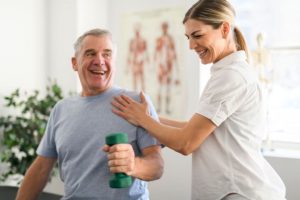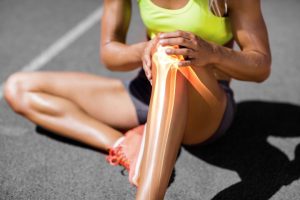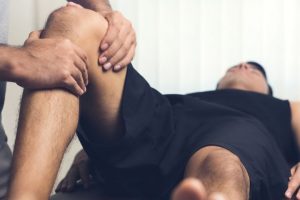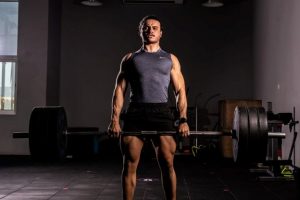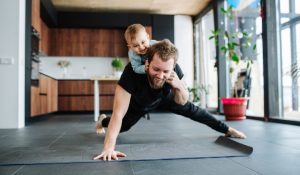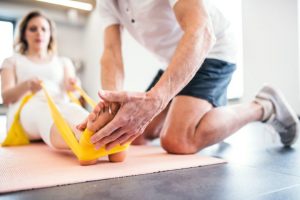Hi, my name is Steve Carling, physical therapist with Petersen Physical Therapy, affiliated with Carling Aquatic & Physical Therapy. I’ve been doing aquatic therapy for many years. I’ve spend a lot of time in the pool and I have the dry skin to prove it.
Because it’s summer now, a lot of people will be spending more time in their pools and it’s a great opportunity to actually do exercise in the water. It’s a little more fun. We’ll try to give you some ideas that you can do so you can actually get a little benefit from just sitting in the pool instead of just lazily lounging in the water.
If you would prefer to watch, rather than read, here is the video we made detailing this routine:
Benefits of Aquatic Therapy
So, the benefits of aquatic therapy are:
Hydrostatic pressure
One, water creates hydrostatic pressure which means that the pressure of the water will push on the extremities to actually improve circulation and help with swelling issues. The biggest benefit is actually that it puts less stress on your joints. Many of our patients that are in the pool have difficulty because of back pain or knee pain or other joint pain. So by being in the water, there’s much less stress on the body and we’re able to accomplish much more exercise than they could on land.
Buoyancy of the water
The buoyancy of the water reduces stress to the joints and the structures of your own body. About 50% of the stress on the joints is reduced by being in chest deep water, and about 25% of the stress on the joints is reduced by being in waist deep water. As you exercise in the water, the water will create a constant pressure against your movement.
Auto-regulating resistance
So one of the advantages is the water is it’s a constant resistance – the harder you push against the water, the harder the water is going to push back. If you just go slower, it’s not creating as much resistance. So, you get to control how strenuous you want the exercise to be on your body.
The Exercises
So, let me show you a few exercises that you can do. You can just have fun in there. It doesn’t have to be done every day. Exercise is good almost every day, but a rest for your body is also appropriate. So, 3-5 times per week would be appropriate, and it may only take about 5-10 minutes at a time just to do some basics that can help you get moving and get stronger, and not get too hot while you’re doing it.
Lateral leg raise
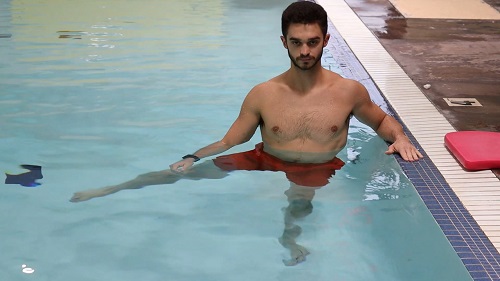
The first exercise that we’re doing here is actually for the hips. You can see that our wonderful student here is swinging his leg in and out. This targets the hip muscles, particularly the muscles on the outside of your hip, known as the abductors, which are very important for stability, for walking, for strength.
He’s just doing about 10 reps on each side. You could do up to 15, 20, or 25. 75 is too many, but you just want to challenge yourself enough by controlling the speed – how fast and how hard you want to push against the water. So, it’s kind of in your hands, how hard you want to work on that.
Aquatic hip extension – rear leg raise
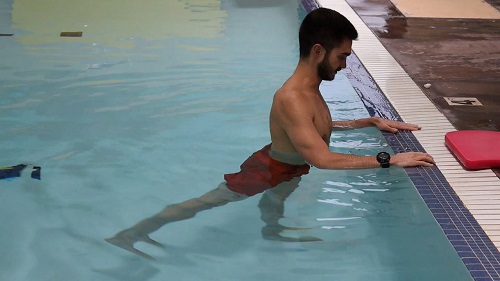
The next exercise is actually a little bit of forward and backward kick motion. Again, working hip muscles, and also working your back a little bit, as far as stabilizing. You can see, he’s keeping a very straight back. You don’t want to be bending over a whole lot, putting stress on other structures including your back. Just focus on the primary hip muscles only.
Again, you control the speed. Shoot for 15-25 reps. You may want to do more than one set. You could do left side, right side, left side, right side – alternating back and forth. Mix it up so your muscles have time to get a good workout and also rest and recover.
Aquatic hip flexion – forward leg raise
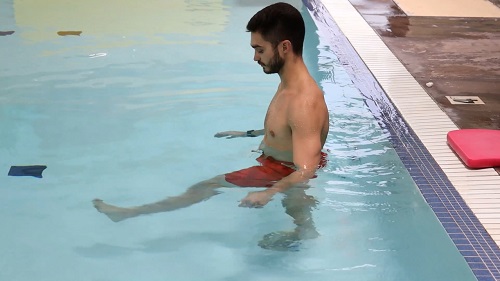
This is similar. You could actually combine these a little bit if you wanted to. He’s focusing on the forward motion of hip flexion. You could also be doing both forward and backward simultaneously in the same motion. We’ve just kind of broken it down so you can see a little more clearly as far as the forward and backward motion. This is a great exercise just to move the whole leg, get the hips strong.
15-25 reps would be appropriate, and again, as we said before, water exercises are more fun. See how much fun he’s having?
Pool Squats
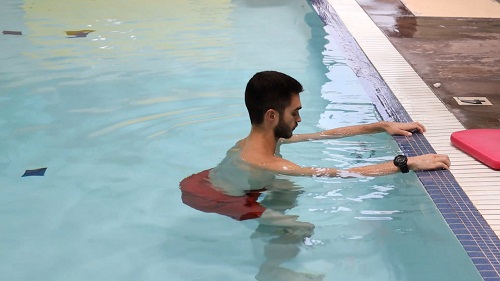
Here’s a really good one. Squats are great for a lot of reasons. They target your muscles in your legs, front and back, as well as your gluteal muscles – a lot of the muscles that keep you strong. You use these muscles for walking, for stairs, for getting in and out of chairs, all that type of stuff. Doing them in the water is obviously easier on the joints and easier on the body. Many people who cannot squat that deeply in a full gravity situation, meaning on land, can do much more motion in the water.
Kickboard push / pull complex
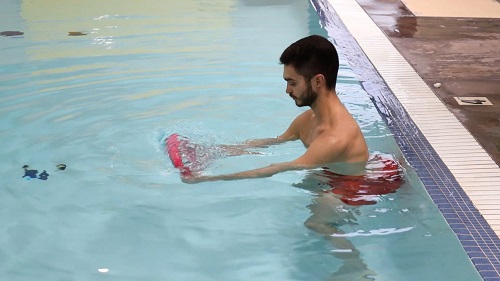
The next exercise is just using a kickboard and pushing it back and forth. Though it may look like the arms are doing a lot of this work, actually the predominant muscles working here are your core muscles. You abdominals and your back muscles. They have to resist against all the pressure that’s being created by the arms pushing that kickboard through the water.
You want to tighten up the midsection – get a real strong, real stable, and real neutral position of your back and spine. Just push back and forth. The arms will get a workout, but that’s not the primary focus of the exercise.
PNF
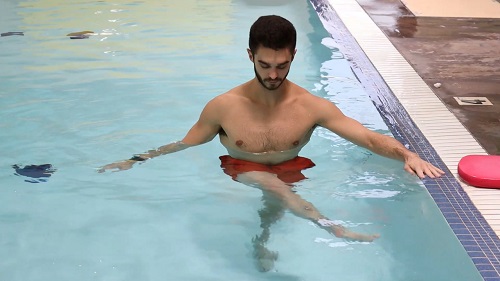
This exercise is actually a combination of what we were doing before, where we were swinging a let forward and sideways. In this case, he’s actually going on a diagonal. He’s moving his leg a little bit forward and back, as well as side to side. One little component he’s adding there, if you can see it, is he’s actually rotating his foot a little bit.
The hip moves in three planes of motion, and so what we’re trying to do there is combine 3 planes of motion across the hip, not just one at a time. Not just forward and back, not just side to side, but combining all three simultaneously, which is really good for a lot of muscle recruitment. The object would be to turn the foot outward a little bit and turn the toes inward as you go across. He’s not doing a whole lot of that in this video, but nonetheless he’s working a lot of muscles through a lot of planes of motion, which is very effective.
He’s borrowing from a principle known as proprioceptive neuromuscular facilitation, but we just like to call it “PNF” because that’s way too many syllables. Another indicator of how many reps to do is just how tired you get, as you are going through the routine.
Step ups
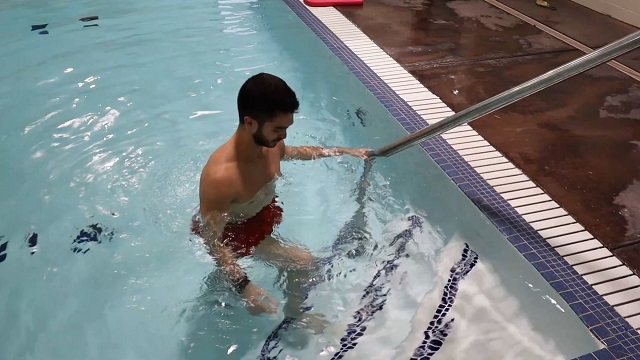
In this case, he is just using the step in the pool as the ledge just to do a basic step up. So, people who struggle with stairs, this would be a great way to be able to do it in the stairs, without having to work as hard because the buoyancy of the water is taking some of the stress away. Your body can do the job fully on its own, but just with a little less resistance overall. 15-25 reps would be appropriate, then switch sides. Maybe if one set doesn’t provide enough fatigue, see if you can get a second set. Left, right, left, right – enough to challenge those muscles to get them strong and make them do a little more work so they are more able to do the job in the future.
You can see he’s not hanging too tight to the rail, or relying on the rail to do most of the work, he’s really just focusing on the legs doing the work.
If you’re feeling good about life, you can even move up from the first step to the second step, which will get harder, because there’s more gravity and less water buoyancy.
In conclusion
Those are some basic aquatic therapy exercises that can be done – they are very helpful for just general leg strengthening, body strengthening, as well as just getting a good form of exercise with less stress on your body.


